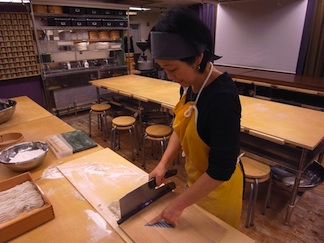On January 7, 2024, JANM welcomed 3,700 guests to ring in the Year of the Dragon at its annual Oshogatsu Family Festival. Families and guests of all ages celebrated 2024 with fun activities, musical performances, a scavenger hunt, and free Museum admission all day to see The Bias Inside Us (through January 28), Glenn Kaino: Aki’s Market (now extended through February 11), The Interactive StoryFile of Lawson Iichiro Sakai, and Common Ground: The Heart of Community.






Oshogatsu kicked off with dance performances by the Nippon Minyo Kenkyukai, Hoshun Kai, an all-volunteer Japanese folk dance group in Los Angeles’s Little Tokyo that preserves the traditions of Japanese folk dance while introducing contemporary interpretations of those same dances. Their performances were dedicated to the late Hashimoto Hoshunbi Sensei and included folk dances about entertainment, fishing, and coal mining. The “Tanko-bushi” or coal miners’ song was especially interesting because the dancers explained that the dance steps symbolize digging for the coal, shoveling it over your shoulder, looking back to check the mine, and pushing the mine cart forward.





Cold Tofu, the nation’s longest-running Asian American improv and sketch comedy group, regaled the crowd with four improvised skits based on the audiences’ suggestions. In Standing, Sitting, Squatting, Leaning, four comics created different scenes with the theme of birthdays while assuming one of the four postures. In Pillars, two young volunteers helped three comics ad-lib a story set at the Parthenon using their suggestions, and in Pop-Up Storybook, four comics improvised a story called “The Velvety Dragon.”
“That book will be available in the JANM lobby at the end of our show,” joked the emcee, Mike Palma.






Longtime volunteer Hal Keimi led a beginner taiko lesson with children and adults of all ages. From children under seven years old to adults in their sixties and seventies, everyone had fun following Keimi’s lead on the drums. Guests also enjoyed Kodama Taiko’s unique mochitsuki demonstrations. The best part? Learning to make freshly made mochi!
Thank you for celebrating the new year with us! We hope that we will see you at our next family festival. Sign up for our email list or follow us on social media to learn about upcoming family festivals.




Photo captions and credits:
Guests explore Aki’s Market and The Bias Inside Us, watch Cold Tofu and Shan the Candyman, go on a scavenger hunt, and make paper crafts. Photos by Joe Akira, Kazz Morohashi, Doug Mukai, and Richard Watanabe.
Hal Keimi leads a taiko lesson for all ages. Photos by Kazz Morohashi and Mike Palma.
Nippon Minyo Kenkyukai embellish their dances with fans, sashes, and castanets, and lead a Tanko-bushi dance lesson. Photos by Joe Akira, Ben Furuta, and Tsuneo Takasugi.
Kodama Taiko performs their traditional and unique mochitsuki (Japanese rice pounding ritual) for a cheering crowd. Photos by Doug Mukai and Mike Palma.



















